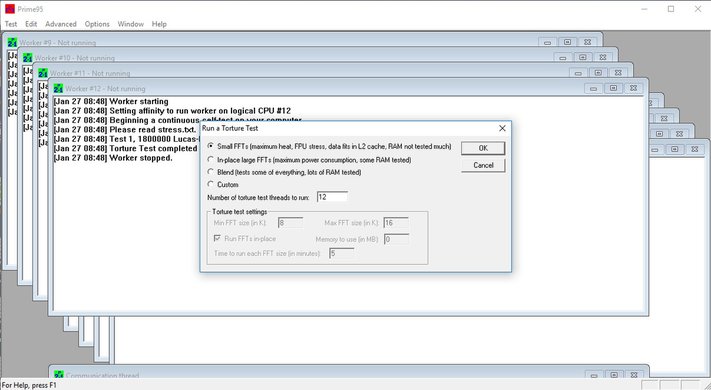What Furmark is for the GPU, Prime95 has been representing for the CPU for years. A true classic, but it has evolved over the years. Current versions support the latest AVX command sets, creating thermal overloads that have washed back. However, not everyone will want to swing this extensive AVX heat leg, so that many users either change the AVX offset in the BIOS or change the AVX offset. googling to older versions of the software.
Therefore, we show how the current versions can be very easily made to switch between the command set extensions. First, however, you should download the latest version here for free.

Selecting the command set extension
Depending on the CPU, you can either make the selection pass automatically, then the latest set is used, e.g. AVX, AVX2 or even AVX512. However, if you want to test in a targeted way, you must have started the program at least once and then close it completely. Only then will the local.txt file be created. Here you add the respective exclusions with the value 0 and the core path to be tested with the value 1. If you are not sure, e.g. which of the SSE variants is supported, then you simply set both to 1, because the program is looking for the fallback itself.
CpuSupportsRDTSC=0 or 1
CpuSupportsCMOV=0 or 1
CpuSupportsPrefetch=0 or 1
CpuSupportsSSE=0 or 1
CpuSupportsSSE2=0 or 1
CpuSupports3DNow=0 or 1
CpuSupportsAVX=0 or 1
CpuSupportsFMA3=0 or 1
CpuSupportsFMA4=0 or 1
CpuSupportsAVX2=0 or 1
CpuSupportsAVX512F=0 or 1
Testing with AVX and Small FFTs
First, we release the incendiary bomb and leave AVX activated automatically without all our own entries. With the setting Small FFTs you get the absolute maximum heat on the computing cores, even if the memory is used rather less extensively, which the numbers prove well:
| CPU Package (PECI) |
Core Average |
Sensor Socket |
Working Memory |
Cpu Watts |
System Watts |
|
|---|---|---|---|---|---|---|
| Reading |
87 °C |
86 °C |
105 °C |
28 °C | 172 W |
252 W |
| Compared to The Max. |
100% |
100% |
100% |
77.8 % | 100% |
100% |
| Review | – Extremely high package temperature for stability tests – rather low storage temperature – very high power consumption of CPU and overall system |
|||||
| Suitability | – Power consumption measurements – Cooling tests in the limit area |
|||||
Testing with AVX and Blend
Using the much more moderate "blend" test, the memory is also more included, and in return the computing cores are loaded a little less. This option is not the worst option for pure stability tests, where it is also possible to calculate errors due to an unstable overclocking, because it is also suitable for longer test runs, as long as the cooling does not weaken.
| CPU Package (PECI) |
Core Average |
Sensor Socket |
Working Memory |
Cpu Watts |
System Watts |
|
|---|---|---|---|---|---|---|
| Reading |
54 °C | 53 °C | 76 °C | 34 °C | 130 W | 160 W |
| Compared to The Max. |
62.1 % | 61.1 % | 72.4 % | 94.4 % | 75.6 % | 63.5 % |
| Review | – normal package temperatures – higher storage temperature – Average power consumption of CPU and overall system |
|||||
| Suitability | – Long-term stability tests – Memory tests (overclocking) |
|||||
Testing with SSE and Small FFTs
If the AVX usage (as described above) is manually overridden, the benchmark also gains in value as a stability test, because most programs will hardly rely on AVX anyway. But then a longer test for possible overclocking instabilities makes more sense again, even if it can never completely replace real application programs.
| CPU Package (PECI) |
Core Average |
Sensor Socket |
Working Memory |
Cpu Watts |
System Watts |
|
|---|---|---|---|---|---|---|
| Reading |
75 °C | 74 °C | 82°C | 28 °C | 107 W | 160 W |
| Compared to The Max. |
86.2 % | 86.0 % | 78.1 % | 77.8 % | 62.2 % | 63.5 % |
| Review | – increased package temperatures – rather low storage temperature – rather higher power consumption of CPU and overall system |
|||||
| Suitability | – Long-term stability tests – Simple cooling tests |
|||||
Testing with SSE and Blend
Once again, the "blend" test involves the memory more and in return the computing cores are a little less loaded. Whether one chooses this variant, which nominally generates the lowest loads of all four variants, is a matter of consideration. This option is particularly suitable for poorly cooled systems such as notebooks or mini PCs. However, the memory load is the same as for AVX and "Blend"
| CPU Package (PECI) |
Core Average |
Sensor Socket |
Working Memory |
Cpu Watts |
System Watts |
|
|---|---|---|---|---|---|---|
| Reading |
53 °C | 52 °C | 70 °C | 34 °C | 98 W | 146 W |
| Compared to The Max. |
60.9 % | 60.5 % | 66.7 % | 94.4 % | 57 % | 57.9 % |
| Review | – low package temperatures – higher storage temperature – lowest power consumption of CPU and overall system |
|||||
| Suitability | – Long-term stability tests for low cooling (notebooks) – Memory tests (overclocking) |
|||||
- 1 - Einführung und Testsystem
- 2 - Prime95 mit AVX oder SSE
- 3 - OCCT mit vier Varianten
- 4 - Aida64: FPU vs. Cache vs. Memory
- 5 - powerMAX, Heavy Load
- 6 - CPU Only: Leistungsaufnahme
- 7 - CPU Only: Temperaturen
- 8 - System: Prime95 + GPU
- 9 - System: MSI Kombustor, OCCT
- 10 - System: Aida64, powerMAX, Heavy Load
- 11 - System: Leistungsaufnahme
- 12 - System: Temperaturen
- 13 - Zusammenfassung und Fazit

































Kommentieren